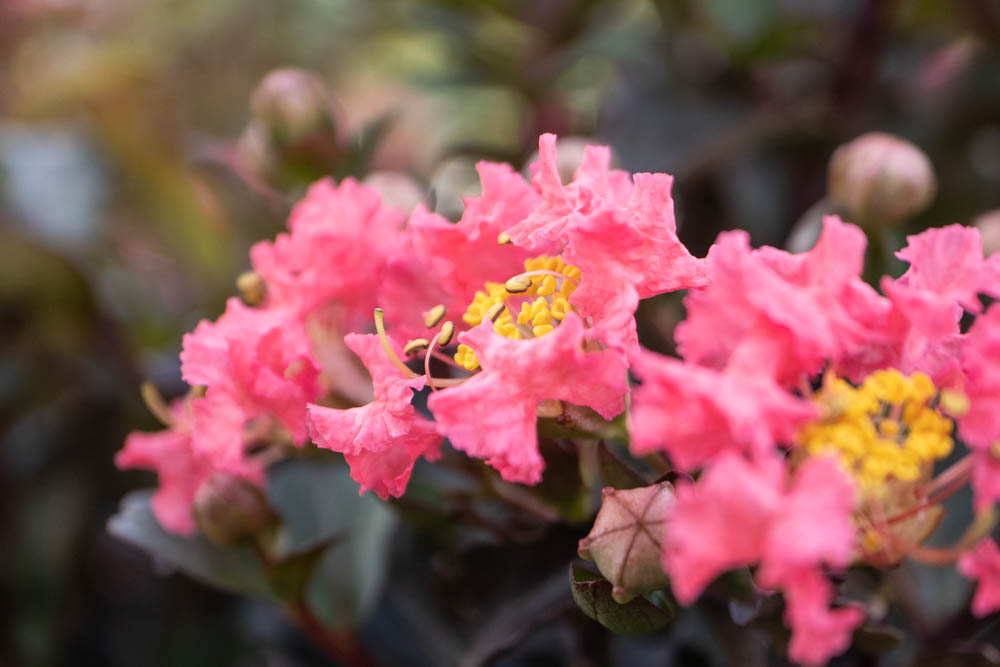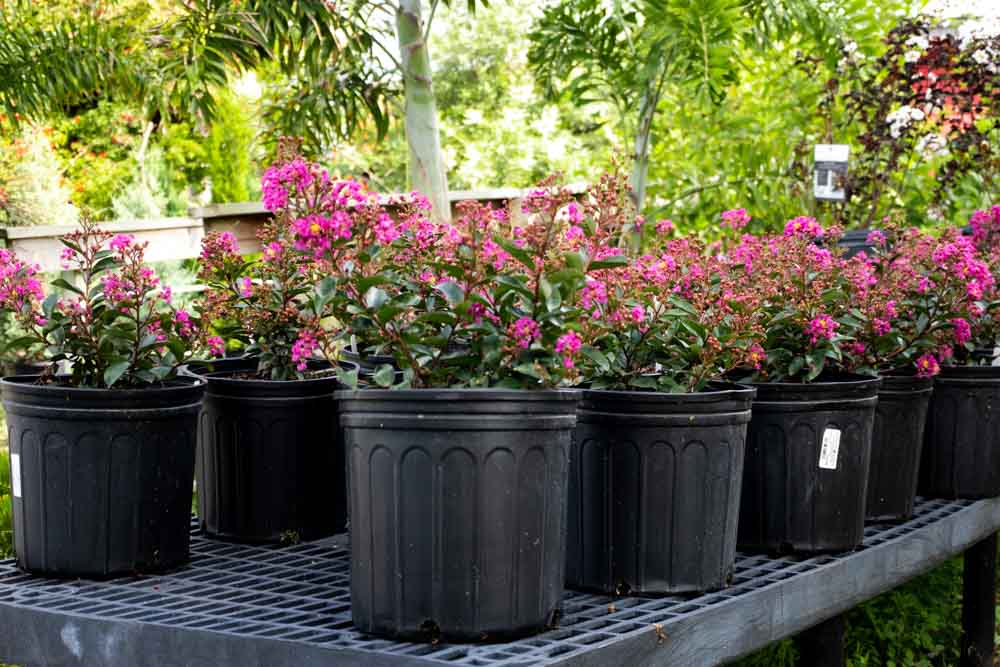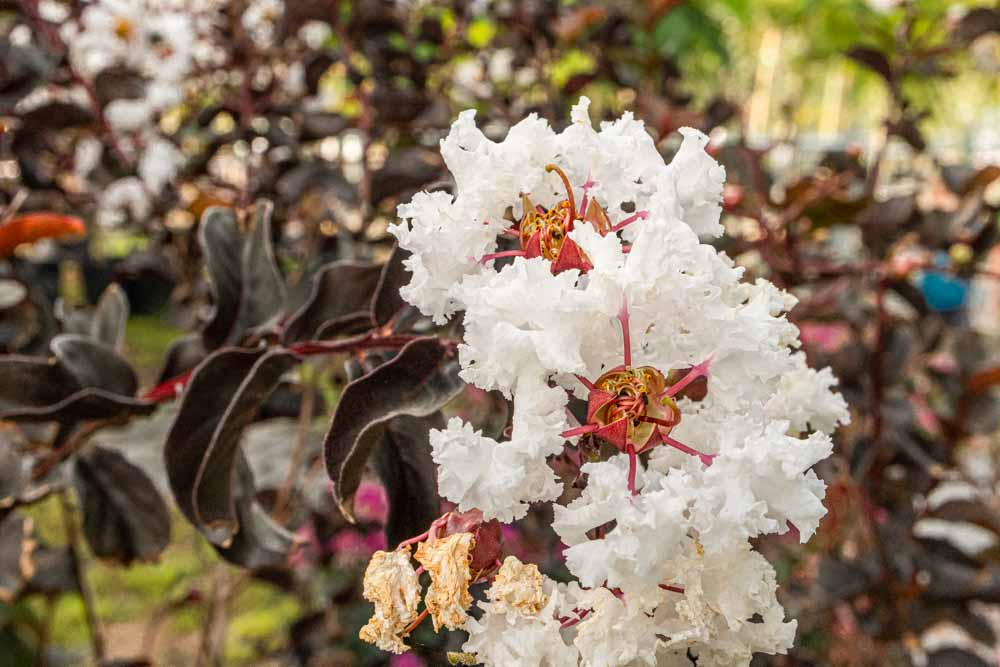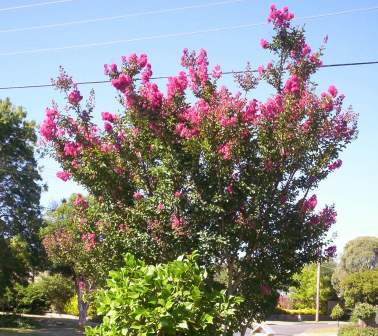by Amanda Rose Newton
Crape myrtles (Lagerstromeia indica) are well-loved here in the southern landscape.
They are a ubiquitous choice for schools, homeowners, and government buildings, and oddly enough there always seem to be a few in front of every Cracker Barrel restaurant.
This is quite something considering they spend a good portion of the year totally nude! The beautiful flowers they are known for will disappear as we make our way into the holidays, yet the allure of the crape myrtle rolls on. From the enchanting peeling bark to its ability to be a tree or a shrub, it’s stood the test of time.

It might surprise you to know that a tree so treasured in the Southeastern United States is actually from China, where it is known as Paj Jih Hung, which loosely translates to “a hundred days red” because of its long bloom season. It is also known as the monkey tree throughout Asia as apparently, monkeys are not able to climb up the peeling, ultra-smooth trunk!
The name “crape myrtle” was given by the English due to the resemblance of the foliage to a typical representative of the myrtle family. The “crape” part is easy to guess after a quick glance at the blooms as they really do resemble crepe paper. It wasn’t until the last century that the well-traveled shrub made its way to America.
Planting Crape Myrtles
Crapes grow well in various soil types, but you can expect them to be happiest in areas that are well-draining and lightly composted. Plants should be placed in the ground at soil level and a mulched ring of three to four feet around the base will help aid in water retention.
It’s important to note that these plants are no match to lawn maintenance equipment and the mulch ring will make the trunk less vulnerable to accidental attacks with the weed whacker.
Crape Myrtle Maintenance
Crape Myrtles are fairly laid back once they are established and can live without regular fertilization.
If you wish to, Espoma Tree-Tone is a slow-to-break-down organic blend that only needs to be applied every 12 weeks or so during the growing season. Remember, your plants do not take up fertilizer during their dormant stage!

Occasional outbreaks of powdery mildew are possible, especially if good air circulation is not well maintained during humid weather. A systemic or organic fungicide will help take care of the issue. Always follow label instructions!
There are resistant strains of crape myrtles that have been developed specifically to avoid this issue altogether. Root rot can occur when there is too much water around the roots, so only water as needed.
The crape myrtle does have a few run-ins here in there with pests. The most common visitors are aphids, which can be controlled organically with insecticidal soap.
Pruning Crape Myrtles
Pruning back crape myrtles is about as difficult as they get. Although intimidating the first time you do it, it will become second nature once you are a few seasons in.
After each blooming season comes to an end, remove old bloom stalks for increased flowering throughout the summer. Prune to your desired shape in late winter. Shrub-form varieties can be pruned into tree form over time, in case you change your mind after purchase.
The Crape Myrtle Rainbow
Growers delight in coming up with new varieties of Crape Myrtles each season. Here are a few of the common choices that do well here in Florida:
Basham Party Pink– As the name suggests, this feature candy pink blooms and reaches 20 feet in height or more. Tree form only.
Black Diamond– loved for its dark foliage, this is a compact shrub form reaching only 10-12 feet in height. The blossom color ranges from white to pink to red.

Center Stage– Another compact shrub, this one is slightly smaller than the black diamond at 8-10 feet. Colors range from coral to red and have dark foliage.
Enduring Summer– For all the purple lovers out there, this lavender variation gets only 5 feet tall and is only available as a shrub.
Muskogee– Perhaps the most iconic of the crapes, the Muskogee is lavender and can be grown in a multiple-trunk form. It will eventually climb to over 20 feet in height.
Natchez– Simple and elegant, this white-blooming, multi-trunk tree form will also reach 20 feet or more in height.
Red Rocket– The name says it all, this truly is the reddest of the reds. It gets over 20 feet tall with a wide sweeping canopy.
Tonto- Bright electric magenta blooms crown this 12-foot stunner. The bark peels and it can be in either a shrub or tree form.
Tuscarora– Beautiful pink blooms with large 20 feet fast growing reach. This is another that looks just as nice left in shrub form.

Whichever one you choose, crape myrtles offer a classic Southern elegance with a dash of worldly experience.


